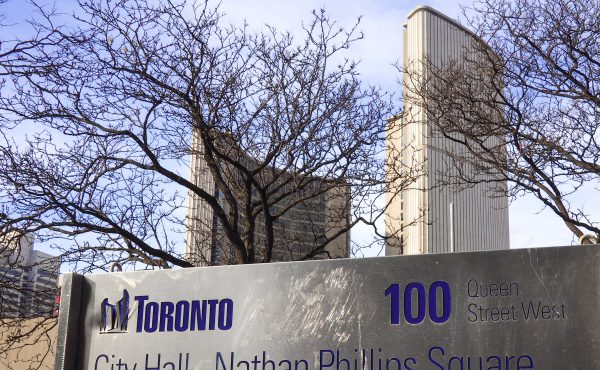EDITOR’S NOTE: Spacing’s Nicole McIsaac spent time Saturday at the rallies downtown; here are some of her observations.
WHOSE STREETS? THEIR STREETS
Contrary to the popular chant of “Whose streets? Our streets,” ringing through the air at random times throughout the weekend, heavy police presence made it obvious that even the “designated free-speech area” wasn’t meant as a place to gather. In fact, anywhere downtown wasn’t an acceptable place to gather. Instead of actual stand-offs, most people simply dispersed. People being boxed in as police tactically surrounded them asked simply “How are we supposed to leave?” or “Is this where you tear gas us?” Sometimes these questions provoked chants of “peaceful protest,” or a multitude of other reminders such as, “The whole world is watching.”
I know it’s not just me here who’s cringing, and like you I spent time this weekend following both mainstream media and Twitter feeds of journalists and people on the ground. I hope that, in the coming days, looped footage of broken windows and unattended police cars being set on fire is replaced by reports from groups of people who were simply there. As I write, this has been the crime of many who police have detained — they were there, they were assembled and they were robbed of that right.
In the case of the mass detainment of protesters at Queen and Spadina on Sunday night, people detained by police “kettling” tactics weren’t even given a window of time, or window of space with which they could peacefully leave. Given the choice of being arrested or kept in the pouring rain — with a chance of being teargassed — many opted to be arrested.
Actions at Queen’s Park on Saturday, as well, felt to me like an over-assertion of how well the Integrated Security Unit could handle themselves and maintain control of the downtown core. By Saturday evening at Queen’s Park, hundreds were hauled away because they simply refused to disperse. Journalists were arrested for not moving quickly enough and Post photographers spent the night in one of many detainment centres, at least one writer working for the Guardian was beaten before arrest. Even a CTV producer was arrested.
THE ACCIDENTAL PROTESTERS
On a Saturday night, in comparison to the numbers of people who are regularly downtown, the streets were relatively deserted. By Sunday night, people felt comfortable enough with the state of things in the downtown core that they could go about their lives. They went out for dinner, watched soccer in bars, went to the gym and walked their dogs in their own neighbourhood at Queen and Spadina.
These people are a different kind of protester, instead of sitting on the ground and chanting “O Canada,” they took back their streets and their city by actually using them as they would any other day of the year. But they were punished for it. Under suspicion of Black Bloc members being among those in the crowd who were peacefully protesting at the corner, and those who were walking through, police on the scene made the immediate decision to cordon off the entire group and process every single person one-by-one.
Bill Blair told television stations Saturday night that the police force’s job, first and foremost, was to protect the dignitaries that came to our city. How this relates to protesters peacefully sitting on the street outside the Novotel Hotel, or singing and dancing outside the detention centre in Leslieville, or going about their business in one of Toronto’s busiest intersections is curious.
WHAT HAPPENED NEXT?
According to the Canadian Civil Rights Association website, “The fact that a protest is disruptive, inconvenient, or noisy is not sufficient grounds to arrest individuals participating in a peaceful assembly.” The CCLA is condemning mass arrests and claims that some of their own monitors were arrested, while Amnesty International is calling for a review into policing tactics surrounding the G8 and G20 summits.
Reports have emerged that people who were released soon after being detained on the weekend were arrested on a “catch-and-release” type action, though police are claiming is not the case. Of the over 900 people who were arrested throughout the weekend, which Now Magazine reports is the biggest number of arrests at a G20 ever, people continue to be released from the Eastern Ave. detention centre today as well as from the temporary courthouse at 2201 Finch Ave, many without charges.
There are of course those who were running around and breaking windows and climbing around in sewers, but instead of chasing them down on Saturday, while the city was in a state of riot, police started operating on a “better safe than sorry” attitude instead of patrolling and waiting for something to happen.
There were moments on Sunday when I was pleased with the way that police were handling themselves. I was deeply dissatisfied with mass amounts of cops in one place, such as the group at Queens Park, on Saturday — dispersing a peaceful crowd practicing their Charter rights, and allowing “anarchists” to run amok through the city. With a more spread out police presence, chances of catching those who were breaking windows and causing other sorts of mayhem is higher than focusing on sit-ins and dance parties. And until the evening on Sunday, and the events at Queen and Spadina, I thought that the day would end without too much hoopla.
I certainly hope that every single person that was caught in a police gauntlet — in the rain, for almost four hours — files official complaints and shares their stories. Hopefully, eventually, the police will feel that those people deserve an apology.
Photo courtesy Steph Davidson






One comment
re those shields: this is sparta?